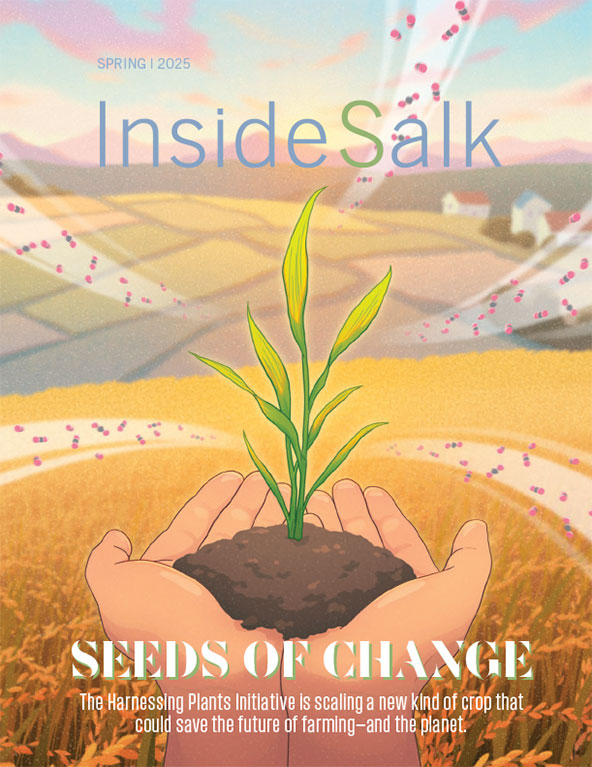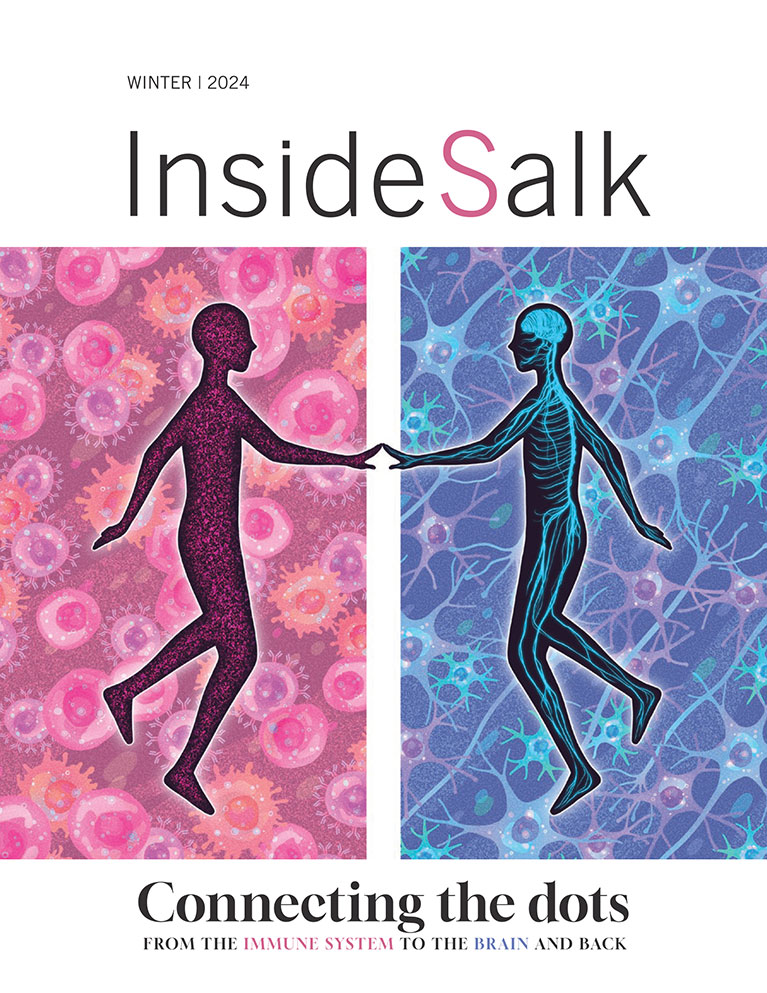Frontiers
What’s so special about Salk?
Everything.
In August 1921, a dozen years before he became President of the United States, Franklin Delano Roosevelt was enjoying some much-needed family time with his wife, Eleanor, and their five children at the family’s summer home on Campobello Island, off the coast of New Brunswick, Canada. After an active day spent sailing, swimming and running races with the children, Roosevelt began to feel achy and chilled. He went to bed early, awaking the next morning with a fever and diminishing control of his legs.
Two weeks later and still quite ill, Roosevelt was diagnosed with poliomyelitis (polio), a highly contagious virus that attacks motor neurons—cells that, among other things, enable us to swallow, breathe and move our limbs. Despite his hopes for a complete recovery, he would never walk unassisted again.
In the early 20th century, before Jonas Salk developed the first polio vaccine, Roosevelt was one of tens of thousands of Americans whose lives were upended by the infection. The experience was so life-changing that Roosevelt became dedicated to finding a cure for polio as well as helping other survivors—mostly children (polio was also known as infantile paralysis)—recover.
Although Salk and Roosevelt would never meet, their shared vision of a world without polio would lead not only to the lifesaving vaccine but also to a pioneering research institution like no other: the Salk Institute.
“Jonas was well aware that the development of his institute would be an evolutionary process, and he viewed it as an experiment.”
– Suzanne Bourgeois

Credit: Special Collections & Archives, UC San Diego.
Unique beginnings
In 1938, during his second term, Roosevelt set up a nonpartisan organization called the Foundation for Infantile Paralysis (later called the March of Dimes), which was dedicated to finding a cure for polio as well as helping survivors. Over the next several decades, the foundation would fund the work of numerous researchers, including a young Jonas Salk, first at the University of Michigan, where he researched an influenza vaccine, and then at the University of Pittsburgh, where he would develop the polio vaccine.
When Salk’s polio vaccine was declared safe and effective in 1955, he instantly became the most famous scientist in the world. With that success, the 40-year-old researcher began to envision an institute at which basic scientific research could be conducted for other human diseases.
One of Salk’s early conversations on the topic was with Leo Szilard, a Hungarian-born physicist who had studied with Albert Einstein in Berlin and was a friend of the Nobel Prize winner. In 1933, Szilard had realized how an atomic chain reaction could be harnessed in a bomb. In 1939, he convinced Einstein, who was then at the Institute for Advanced Study in Princeton, to write a letter to President Roosevelt warning him that the Germans were attempting to make an atomic bomb. (A one-act play about Szilard’s efforts to control the bomb, Uranium + Peaches, premiered at the Salk Institute on June 21, 2018.)
Szilard, who turned to biology after World War II, had long dreamed of an institution devoted to public health research. So when he met Salk at a biology conference in 1956, the two had a great deal to discuss. A few years later, Szilard would be among the first Nonresident Fellows at the Salk Institute—faculty members not permanently based at the Institute.
Jonas Salk also consulted another physicist, Robert Oppenheimer. Both Szilard and Oppenheimer were part of the Manhattan Project, which was a US government research project that ran from 1942 to 1945 to develop the first atomic bomb. The effort resulted in the bombs dropped on Hiroshima and Nagasaki, Japan, leading to the end of World War II. After the war, Oppenheimer became head of the Institute for Advanced Study. That institute appealed to Salk as a model for his own. Coincidentally, Oppenheimer was invited to be on a committee to assess whether to establish Salk’s proposed institute at the University of Pittsburgh.
When those negotiations stalled, Oppenheimer, who respected what Salk was attempting, asked whether Salk had considered going to California.
Salk had, in fact, been considering a number of locations for his institute, among them Palo Alto and La Jolla, California. The location decision was a difficult one, so Salk reached out to a friend and confidant, famed journalist Edward R. Murrow, for advice. Murrow had become a household name through his coverage of World War II for CBS. His 1955 coverage of the polio vaccine made Jonas Salk a household name as well, and the two became close. In 1961, Murrow would become a member of the Salk Institute’s first Board of Trustees.
Ultimately, the offer of land from the City of San Diego and proximity to the new UC San Diego campus made La Jolla the more attractive option, and the Salk Institute was founded there—at least on paper, to begin with—in 1960.
“Jonas was well aware that the development of his institute would be an evolutionary process, and he viewed it as an experiment,” says Professor Emerita Suzanne Bourgeois in a book she wrote about the Institute (see sidebar, page 21). “The experiment continues today, and in these changing times the Salk Institute is evolving and adapting as well. It has the brains that made it a scientific success story, and the inspirational building that made it a historical landmark.”
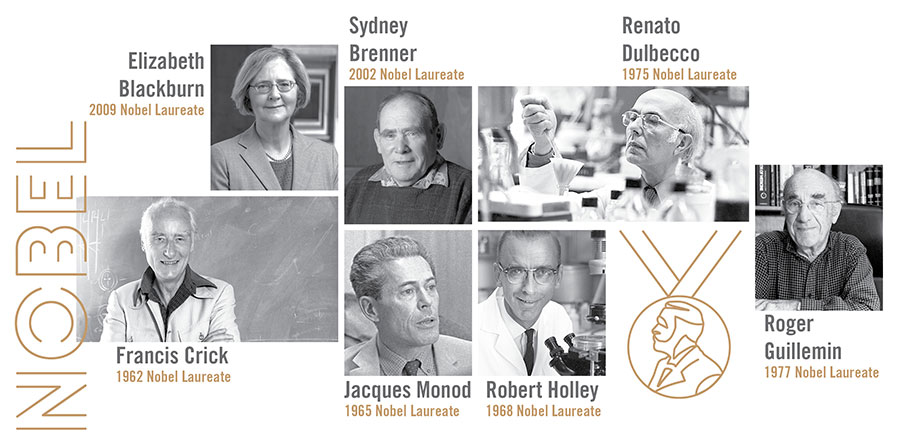
Exceptional people
As negotiations for an institute location were underway in 1959-60, Salk was busily recruiting faculty. Salk offered something few research institutions did—an extraordinary amount of freedom. No teaching, no clinical work, no intellectual constraints—faculty would not be pigeon-holed into research “silos” but could explore ideas across disciplines, learning with and from each other.
This appealed to biophysicist Francis Crick, who had discovered the double-helix structure of DNA with James Watson in 1953 and would win the Nobel Prize for that discovery in 1962, the same year he became a Nonresident Fellow at the Salk Institute. That same year, Salk’s vision also attracted biochemist Jacques Monod, who would win the Nobel Prize in 1965 for some of the earliest work showing how genes are regulated (turned on or off). Virologist Renato Dulbecco left Caltech for the Salk Institute in 1962, also. In 1975, he would win the Nobel Prize for the discovery that viruses can cause cancer by inserting genes into the chromosomes of infected cells. Chemist Robert Holley left Cornell University for Salk in 1968, the same year he won the Nobel Prize for his role in discovering how a molecule called tRNA transports the building blocks of proteins—amino acids—based on the DNA code. And neuroscientist Roger Guillemin left Baylor College for Salk in 1970. In 1973, he discovered a brain hormone, somatostatin, which is used to treat neuroendocrine tumors and other conditions. In 1977, he won the Nobel Prize for his discovery of peptide hormones in the brain.
These pioneering scientists—several already famous—were willing to leave the safety of established universities for an entirely new type of institution and exemplified the daring approach to scientific discovery that has come to characterize the Salk Institute.
Walter Eckhart joined Salk as a postdoctoral scholar in the lab of Renato Dulbecco in 1965 and became one of the first assistant professors at the Institute in 1969, remaining until retiring as professor emeritus. Eckhart, who died unexpectedly in June 2022, was a leader in understanding cell growth and the biology of cancer and served as director of the Salk Cancer Center and Molecular and Cell Biology Laboratory for more than 30 years.
“I was attracted by the world-class research being done at the Institute,” said Eckhart shortly before his death. “The collaborative, interactive environment was exceptional.”
Professor Emerita Catherine Rivier arrived as a graduate student in 1970, moving to the Institute with her mentor, Roger Guillemin. She became an assistant professor shortly thereafter. “What I liked best about the Institute was that we were left alone to do our research, and I cannot tell you how important and precious this was, particularly when compared to what my colleagues elsewhere had to deal with,” says Rivier. “No teaching unless we wanted to, very limited committee participation and an administration that supported us but stayed out of our way. This allowed us to devote all our time and energy to research, which was a unique gift.”

“The remarkable history and architecture of the Institute inspires our scientists daily to forge new scientific paths with the same bold spirit of discovery as the Institute’s founders.”
– Rusty Gage
Inspiring and collaborative environment
As the number of notable scientists and supporters of the new institute grew, Jonas Salk looked for an architect who could design a building that embodied his pioneering idea of collaborative research without intellectual boundaries.
He found such a partner in Louis Kahn, a University of Pennsylvania architecture professor who was building a laboratory for the university. Their shared interest in the interplay between art and science led Salk to ask Kahn to “create a facility worthy of Picasso.”
Kahn’s resulting structure of concrete, steel, teak and travertine marble has been called “a cathedral to science” and is considered one of the finest examples of modern architecture in the world. Every year, thousands of domestic and international visitors marvel at the majestic building high atop a bluff overlooking the Pacific Ocean.
Salk wanted the scientists working within the concrete walls to be inspired by the location and the structure, whose marble courtyard forms what Mexican architect Luis Barragán termed “a façade to the sky.” Salk wanted them to interact and collaborate, and Kahn’s design encourages this with continuous expanses of laboratory spaces without permanent walls, where one lab runs into the next. Shared kitchens, lounges and meeting rooms further promote a sense of community.
Jonas Salk’s strategy was effective: Scientists at the Institute are inspired to ask big questions and make groundbreaking discoveries.
“Cross-disciplinary collaboration is one of the best ways to approach the types of complex scientific and health-related questions we ask at Salk.”
– Susan Kaech
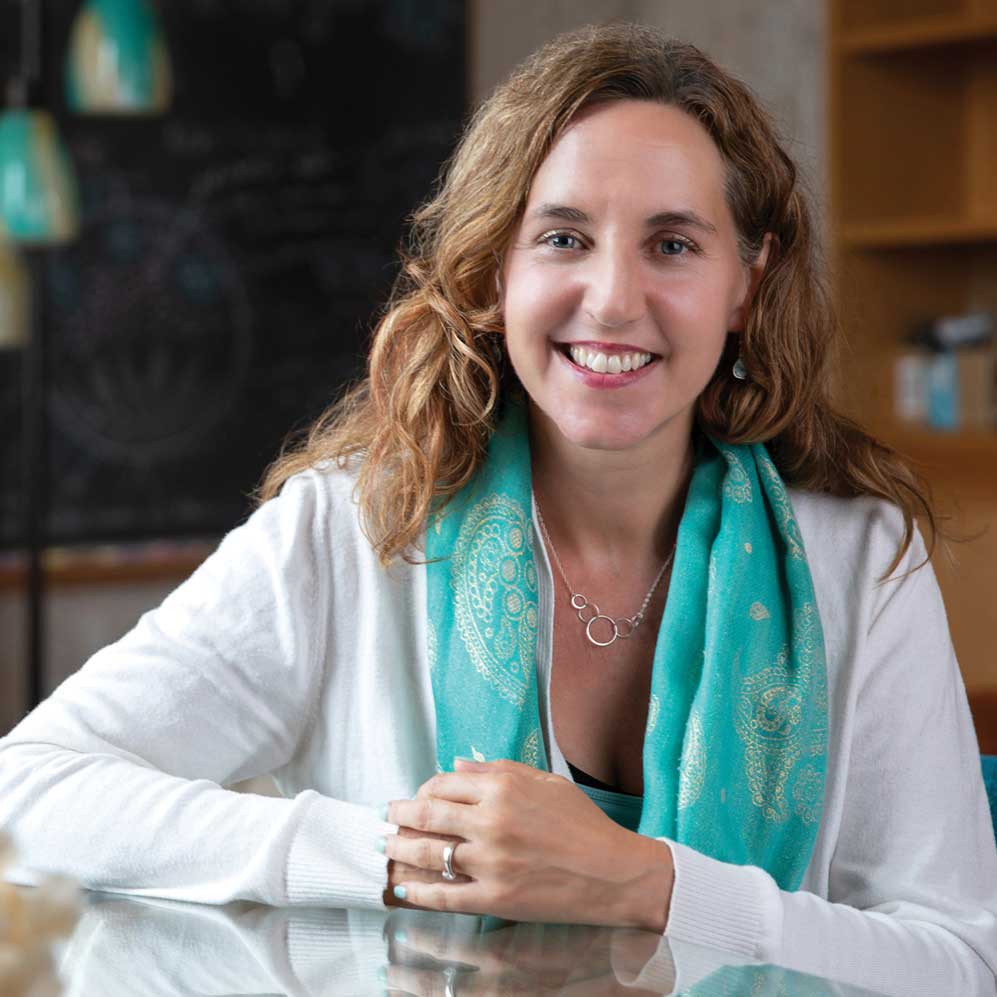
Conversations that drive change
Biophysicist Francis Crick and chemist Leslie Orgel, who both arrived at the Institute in 1964, met regularly for lunch to discuss the origins of life and other topics. Orgel and Crick were early proponents of the idea that life on Earth was based on RNA (DNA’s cousin) before it was based on DNA, a concept known as the “RNA World” hypothesis. Their conversations led to efforts to re-create replicating, evolving RNA molecules in a test tube through a combination of chemistry and directed evolution. Salk Professor and Chief Science Officer Gerald Joyce, who was a student with Orgel, continues to be a leader in this field. Re-creating plausible facsimiles in the lab may give insight into early evolutionary processes, as well as how to design synthetic RNA molecules for therapeutic uses in cancer, immune disorders and other diseases.
“Those were heady days at Salk,” Joyce says. “Both when Crick and Orgel were leaders at the dawn of molecular biology, and when I was a student here in the 1980s and the opportunity to reconstruct RNA-based life first became an experimental possibility.”
In 2007, neuroscientists Professor Edward Callaway and his graduate student Ian Wickersham came up with a technique that revolutionized brain research. A key piece of this method came from a collaboration with then-Salk Professor John Young, a virologist now at Roche. Callaway was describing to Young the problems with using viruses that naturally infect neurons, such as rabies, to trace connections between the mammalian cells used in the lab. Because rabies spreads nonstop between cells, it’s very hard to devise an accurate map of how individual neurons are connected to one another, which is essential if we want to understand how neuronal communication is disrupted in diseases such as schizophrenia, autism and Alzheimer’s.
From a lab in Germany, Callaway’s team had already received a genetically modified rabies virus that didn’t spread nonstop, but they were having difficulties targeting it to the specific neurons of interest. Young immediately had a solution: use a protein combination found in a bird virus that his lab studied. The EnvA protein on the outside of the bird virus gets into bird cells by attaching to a receptor protein on the cells called TVA. EnvA is like a key and TVA is like a lock; together they enable entry into a cell.
Wickersham worked with Young’s postdoctoral researcher to customize the German virus to carry the EnvA “key” on the outside. Then, by genetically modifying the mammalian neurons of interest with the TVA “lock,” they were able to selectively infect those cells. Fluorescent proteins expressed from the virus allowed the researchers, using microscopes, to see the path traced between connected cells. The method, now known as monosynaptic neural circuit tracing, has become one of the most useful tools in neuroscience research.
More recently, conversations between faculty on the topic of aging have led to several exciting collaborations. Professors Jan Karlseder, an expert on telomeres (the protective DNA caps at the end of chromosomes), and Gerald Shadel, an expert in mitochondria (structures that generate energy for cells), have teamed up to explore cross talk between the two. So far, they have discovered that shortening telomeres kick off a cascade of molecular signals that ultimately trigger the destruction of aging, unstable cells with critically short telomeres, preventing them from becoming cancerous. Stabilizing this pathway could offer a new approach for preventing age-related cancers.
Associate Professor Diana Hargreaves, who studies how mutations can make cells forget their identity and turn cancerous, and Professor Susan Kaech, director of the NOMIS Center for Immunobiology and Microbial Pathogenesis, are working together to study cancer immunotherapy—using the body’s immune system to recognize and destroy cancer.
“Cross-disciplinary collaboration is one of the best ways to approach the types of complex scientific and health-related questions we ask at Salk,” says Kaech. “Other places may talk about the importance of collaborating, but Salk actually encourages and supports it with institutional resources.”
Some of Salk’s more unusual collaborations involve plants. Professor Wolfgang Busch, co-director of the Harnessing Plants Initiative, has teamed up with Professor Reuben Shaw, director of the Salk Cancer Center, to study starvation signals in plants. Shaw’s cancer research lab has been studying genes altered in lung cancer whose normal function is to sense when cells are starving for nutrients. It turns out the cancer genes go so far back in evolutionary time that a common ancestor of plants and animals passed them on to both groups. Thus, these genes also control the response to starvation in plants.
Busch and Shaw wondered whether one of the genes, AMPK, might also be active in plants. Recently, Shaw’s team had some new potential activators of the AMPK pathway in human cells and were curious to see whether any of them might also trigger responses in plants and what effect that might have on roots and carbon storage, which is Busch’s area of expertise. Their preliminary work suggests some AMPK activators are active in plants and might prove helpful to the Initiative’s effort to increase the amount of carbon plants can store in their roots as a means to mitigate climate change.
“Faculty are attracted to Salk because of its intimate size and the opportunity to think really big about their field,” says Shaw. “There aren’t many other places where a cancer biologist and a plant biologist would team up, but at Salk, collaborations like Wolfgang’s and mine happen naturally. It’s early days, but it’s the kind of cross-pollination that could only happen at Salk.”
Plants use sensory proteins to detect and respond to touch signals from animals and neighboring plants. With a 2022 Salk Innovation Grant, Professor Joanne Chory, Associate Professor Sreekanth Chalasani and Staff Scientist Carl Procko will investigate these proteins to see if they are sensitive to high-frequency sound waves. The work could help scientists modify how plants behave in the presence of other plants and contribute to the growing body of research on “sonogenetics,” a method Chalasani developed for noninvasively controlling cells with sound waves. Their findings could also lead to new ways for treating conditions like chronic pain, epilepsy and PTSD.
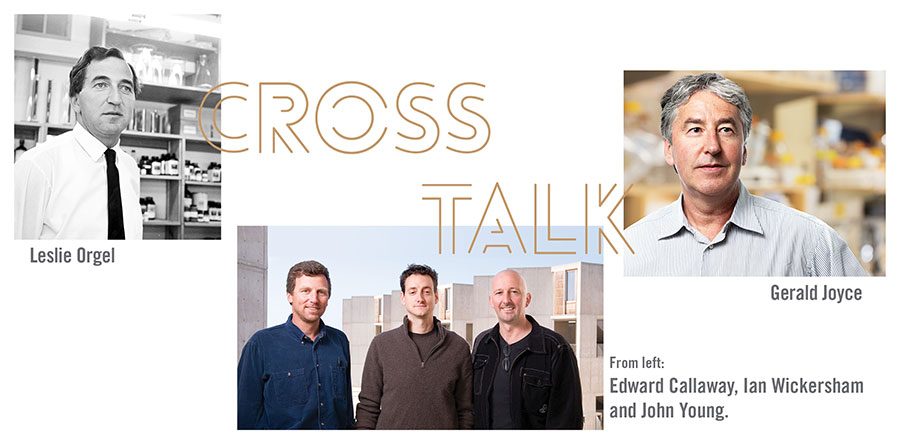
A history of pioneering discoveries
In 1979, Professor Tony Hunter discovered a molecular switch called tyrosine phosphorylation, which turns cells cancerous. The discovery enabled the development of an entire class of lifesaving cancer drugs called tyrosine kinase inhibitors, which includes Gleevec, Iressa and Tarceva.
In 1985, Professor Ronald Evans discovered a large family of molecules called nuclear hormone receptors, which respond to various steroid and thyroid hormones as well as to vitamins. Because these hormones help control sugar, salt, calcium and fat metabolism, they affect our daily health as well as treatment of disease. The receptors Evans discovered are primary targets in the treatment of breast cancer, prostate cancer, pancreatic cancer and leukemia, as well as osteoporosis and asthma.
One of the receptors, PPAR delta, has led to a new class of PPAR delta drugs called exercise mimetics, which promote the benefits of fitness without the need to train. Clinical trials are underway on these drugs, which represent an important advance in addressing problems arising from excess weight and obesity, such as frailty, muscular dystrophy and type 2 diabetes.
Also in 1985, Professor Ursula Bellugi, a pioneer in the neurobiology of American Sign Language, led the way to the watershed discovery that the left hemisphere of the brain becomes specialized for languages, both spoken and signed. (See In Memoriam feature)
In 2002, Professor Rusty Gage, now Salk’s president, discovered that—contrary to the thinking at the time—the adult brain continues producing new neurons throughout the life span in a process called neurogenesis.
“The story of the Salk Institute’s origins is the story of a number of 20th century icons, including Jonas Salk himself,” says Gage. “The remarkable history and architecture of the Institute inspire our scientists daily to forge new scientific paths with the same bold spirit of discovery as the Institute’s founders.”
—and we’re just getting started
Today, Salk faculty are making discoveries that may one day turn the tide on Alzheimer’s, aging, cancers, climate change and more. The Institute that Jonas Salk established in 1960 is unique among elite research institutions for its exceptional history, visionary collaboration-promoting design and trailblazing faculty, past and present.
“Salk truly is different than any other research organization,” says Gage. “Our brilliant faculty, inspired by Louis Kahn’s magnificent building, are committed to Jonas Salk’s vision of helping humanity through basic scientific research.
Salk’s first female faculty
Although women were not well represented in science for much of the 20th century, four of Salk’s early faculty were highly accomplished female scientists. Ursula Bellugi and Suzanne Bourgeois were recruited to the Institute in 1968 and 1969, respectively; Catherine Rivier joined in 1970. Marguerite Vogt arrived in 1963 as a research fellow in Renato Dulbecco’s group and was appointed research professor in 1973.
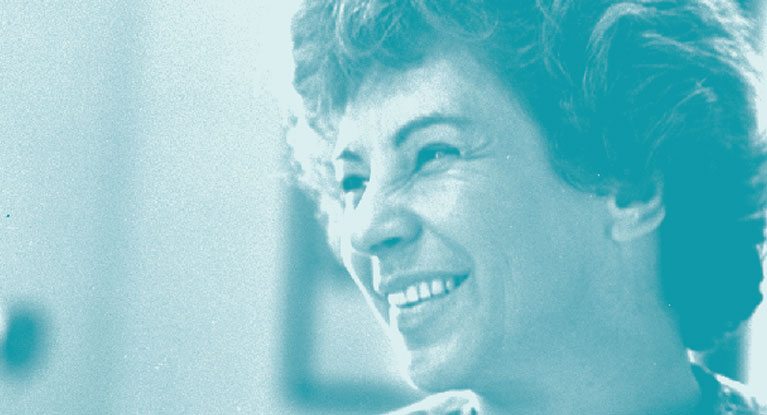
Professor Emerita Ursula Bellugi pioneered the study of the biological foundation of language. She is regarded as the founder of the neurobiology of American Sign Language (ASL) because her work was the first to show it as a true language as processed by the brain, revealing more about how the brain learns, interprets and forgets language. Her expertise in neurobiological, genetic and behavioral studies allowed humanity to better understand Williams syndrome and autism, two conditions that affect social behaviors in opposite ways. Together, her studies on Williams syndrome, autism and sign language helped paint a picture of the biology humans use to interact with the world around us. In 2019, the Salk Women & Science program renamed its Trailblazer Award in honor of Bellugi, who established an endowed fund to support those who have pioneered changes within the STEAM (science, technology, engineering, art and math) fields. Bellugi died on April 17, 2022, at the age of 91. (Read more about Bellugi’s life and legacy here.)
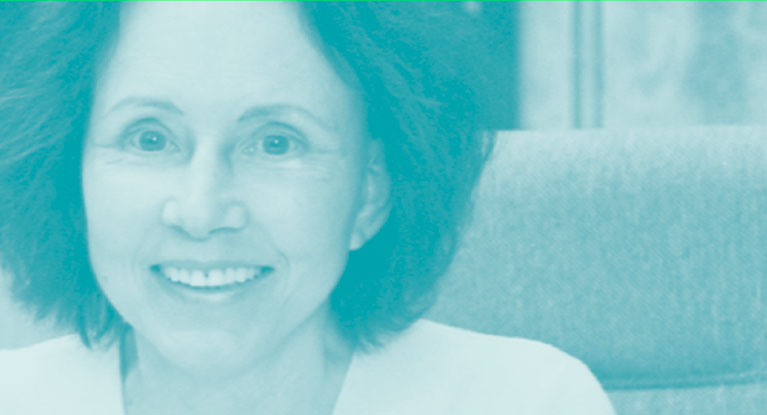
Professor Emerita Suzanne Bourgeois conducted pioneering work on the regulation of gene expression—the process cells use to turn genes on or off—using the bacterial lactose (lac) operon as a model system. In the 1960s, when little was known about the circuit, Bourgeois demonstrated that the lac repressor was a protein. She used the system for the first characterization of the interaction of a regulatory protein with DNA. She later studied the regulation of genes in animal cells and eventually identified compounds that could be useful to reverse multidrug resistance in cancer. After Bourgeois retired from Salk, she wrote the authoritative book on the founding of the Salk Institute, Genesis of the Salk Institute: The Epic of Its Founders. Bourgeois was married to one of the Institute’s founders, Melvin Cohn, from 1963 until his death in 2018. She established the Suzanne Bourgeois Women & Science Fund to advance the work of female Salk faculty.
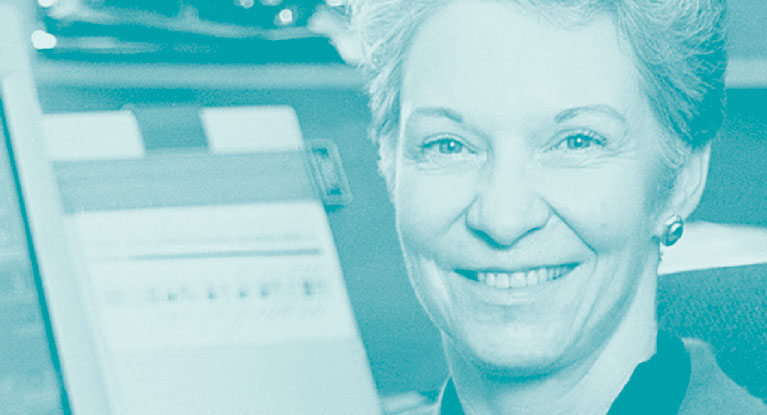
Professor Emerita Catherine Rivier was instrumental in explaining how specialized areas of the brain respond to stressors and communicate with the rest of the body via hormones. She studied how a variety of stressors such as fear, avoidance of unfavorable environments, infection, inflammation and drugs of abuse are conveyed to the brain, and how the hypothalamus mounts adequate responses. Rivier also investigated the role of the hypothalamic peptide GnRH on testicular function. In collaboration with her husband and colleague, Salk Professor Jean Rivier, she designed antagonists to this peptide, which are currently used clinically to treat steroid-dependent conditions such as prostate cancer, endometriosis and precocious puberty. Finally, her team identified a new pathway through which the brain controls the activity of the testes, a discovery that offered insights into puzzling cases of low testosterone secretion connected to stressors or diseases. In 2018, Catherine Rivier was honored with the inaugural Trailblazer Award from Salk Women & Science.
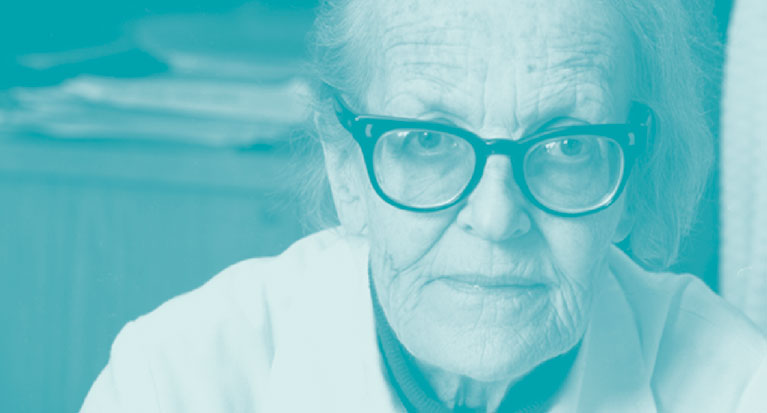
Research Professor Marguerite Vogt was a Salk icon until she retired in 1993. Born in 1914 to German neuroscientists, Vogt grew up studying the genetics of fruit flies. She obtained her medical degree from the University of Berlin in 1937, but her work and life were disrupted by World War II. In 1950, she immigrated to the US to take a research position at Caltech, where she met Renato Dulbecco (see more on page 16). The two collaborated on polio studies and were the first to successfully grow the polio virus in the lab. In 1963, she followed Dulbecco to the Salk Institute, where they worked on cancer. Vogt contributed to the work for which Dulbecco won the Nobel Prize in 1975. Not one to care about accolades for herself, Vogt worked 10-hour days into her 90s and educated or helped train scores of scientists, young postdoctoral fellows and graduate students. Those under her tutelage include four Nobel Prize laureates. Vogt died in 2007 at age 94.
Are you up for the challenge?
Featured Stories
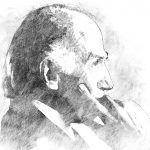 What’s so special about Salk? Everything.An exceptional history, visionary design and trailblazing faculty make the Salk Institute unique among elite research institutions. And we’re just getting started. Today, Salk faculty are daily making discoveries that may one day turn the tide on Alzheimer’s, aging, cancers, climate change and more.
What’s so special about Salk? Everything.An exceptional history, visionary design and trailblazing faculty make the Salk Institute unique among elite research institutions. And we’re just getting started. Today, Salk faculty are daily making discoveries that may one day turn the tide on Alzheimer’s, aging, cancers, climate change and more.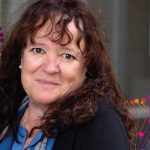 Margarita Behrens—Master of brain circuitsGrowing up in Chile, Research Professor Margarita Behrens was torn between becoming an architect and a scientist. She ultimately decided to pursue biochemistry. Now at Salk, Behrens studies how neurons develop in the brain. Her findings have implications for neurodevelopmental disorders such as schizophrenia and autism.
Margarita Behrens—Master of brain circuitsGrowing up in Chile, Research Professor Margarita Behrens was torn between becoming an architect and a scientist. She ultimately decided to pursue biochemistry. Now at Salk, Behrens studies how neurons develop in the brain. Her findings have implications for neurodevelopmental disorders such as schizophrenia and autism.
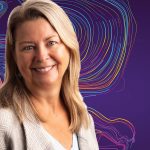 Julie Auger—Shaping Salk’s science through shared resourcesJulie Auger’s mother was at a conference in the mid-1980s when she met Jonas Salk. She got his autograph and mailed it to Auger with a note saying, “Don’t ever stop trying to achieve your dreams.” Auger took her mom’s advice, and today she is the executive director of Research Operations at the Salk Institute.
Julie Auger—Shaping Salk’s science through shared resourcesJulie Auger’s mother was at a conference in the mid-1980s when she met Jonas Salk. She got his autograph and mailed it to Auger with a note saying, “Don’t ever stop trying to achieve your dreams.” Auger took her mom’s advice, and today she is the executive director of Research Operations at the Salk Institute.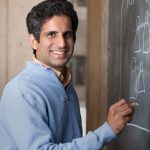 Gaurav Mendiratta— Using math to solve cancerJumping from theoretical physics to cancer research with no prior training in biological sciences wasn’t an easy transition for Gaurav Mendiratta. Couple this with a move across the world and the birth of his first child shortly after starting his postdoctoral training in a newly opened laboratory—Mendiratta had his work cut out for him.
Gaurav Mendiratta— Using math to solve cancerJumping from theoretical physics to cancer research with no prior training in biological sciences wasn’t an easy transition for Gaurav Mendiratta. Couple this with a move across the world and the birth of his first child shortly after starting his postdoctoral training in a newly opened laboratory—Mendiratta had his work cut out for him. A trailblazer’s lasting legacy: Ursula Bellugi bridged humanity and scienceDespite being a world-renowned, award-winning scientific pioneer, Distinguished Professor Emerita Ursula Bellugi didn’t like to say she was smart. Instead, she credited her tremendous success to her insatiable curiosity and her willingness to ask the right questions. This past spring, the world lost a true trailblazer.
A trailblazer’s lasting legacy: Ursula Bellugi bridged humanity and scienceDespite being a world-renowned, award-winning scientific pioneer, Distinguished Professor Emerita Ursula Bellugi didn’t like to say she was smart. Instead, she credited her tremendous success to her insatiable curiosity and her willingness to ask the right questions. This past spring, the world lost a true trailblazer.
